Specialist advice on styling your staircase according to material
Different balustrade materials and designs can create very diverse effects, completely changing the look and feel of a hallway and opening up a wide range of options for homeowners. The only difficulty is knowing what style to choose!
With this in mind, we enlisted further help from the experts…
We asked our panel of interior specialists to recommend styling ideas to suit different staircase materials. Here’s what they suggested:
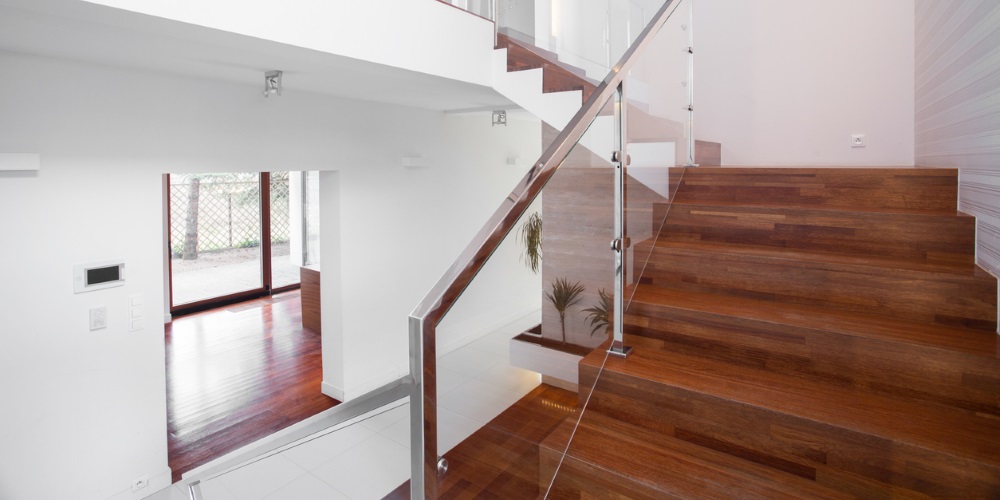
Glass
|
Victoria: Glass is a key element, especially for a truly minimalistic look. The biggest companion for a glass staircase is quality lighting—depending on the style of the property this can either be a chandelier casting decorative patterns onto and through the glass or well-placed spotlights in the ceiling guiding you up and down the stairs and showcasing the quality of the material. |
Louisa: Glass can work well in both contemporary and classic designs. If budget allows, I’d always specify frameless glass balustrades to create a seamless, clean look and help with gaining as much natural light as possible. I’d also use glass to focus on the architectural elements such as a polished plaster wall, or to emphasise exposed beams within a barn development. The balustrade essentially becomes invisible. I’d never specify metal supports and handrails for a residential project, as they remind me too much of offices and other commercial spaces. |
|
|
Katy: Glass staircases help give the illusion of space. They create clean lines with little fuss and help throw emphasis onto surrounding features such as an oak staircase and banister, panelled walls or even feature lighting. Generally, glass keeps the space feeling light and bright. In a contemporary space I’d give extra attention to the surrounding materials on the floor and walls as the glass will highlight and possibly even reflect them. |
Evette: A glass staircase makes a strong statement. The key is the translucency—because of this, walls are often left as bare brick or stone or kept pattern-free with neutral tones so they can be viewed through the glass as whole. Large artwork could always be used at the top‑facing wall of the stairs to complete the journey of drama. The illusion or emphasis of space is statement here. |
|
|
Charlotte: Glass is a very contemporary material. I’d use concealed lighting recessed into a false ceiling, indirectly lighting the space to give a sleek, modern look that will complement the glass. If you were to frost the glass, you can create some beautiful looks by using the entire banister as a diffuser for light shining through it. |
||
Katy: Glass staircases help give the illusion of space. They create clean lines with little fuss and help throw emphasis onto surrounding features such as an oak staircase and banister, panelled walls or even feature lighting. Generally, glass keeps the space feeling light and bright. In a contemporary space I’d give extra attention to the surrounding materials on the floor and walls as the glass will highlight and possibly even reflect them.
Evette: A glass staircase makes a strong statement. The key is the translucency—because of this, walls are often left as bare brick or stone or kept pattern-free with neutral tones so they can be viewed through the glass as whole. Large artwork could always be used at the top‑facing wall of the stairs to complete the journey of drama. The illusion or emphasis of space is statement here.
Charlotte: Glass is a very contemporary material. I’d use concealed lighting recessed into a false ceiling, indirectly lighting the space to give a sleek, modern look that will complement the glass. If you were to frost the glass, you can create some beautiful looks by using the entire banister as a diffuser for light shining through it.
Louisa: Glass can work well in both contemporary and classic designs. If budget allows, I’d always specify frameless glass balustrades to create a seamless, clean look and help with gaining as much natural light as possible. I’d also use glass to focus on the architectural elements such as a polished plaster wall, or to emphasise exposed beams within a barn development. The balustrade essentially becomes invisible. I’d never specify metal supports and handrails for a residential project, as they remind me too much of offices and other commercial spaces.
Victoria: Glass is a key element, especially for a truly minimalistic look. The biggest companion for a glass staircase is quality lighting—depending on the style of the property this can either be a chandelier casting decorative patterns onto and through the glass or well-placed spotlights in the ceiling guiding you up and down the stairs and showcasing the quality of the material.
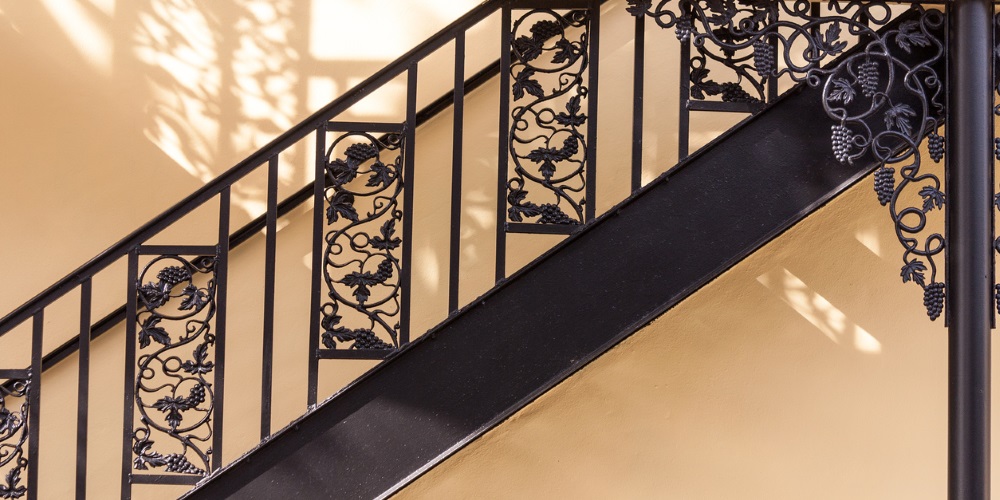
Metal
|
Evette: Lots of homes have metal balustrades, which range from the very simple to the ornate. I love the pairing of stone steps and cast-iron rails where the use of strong heritage colours—greens and reds and yellows—work particularly well. In a modern setting I like to use coloured-edged sisal runners on dark-painted wooden stairs and I also like to see the use of metal handrails and banisters in loft and barn conversions. Modern pendant lights lend themselves to lighting these type of staircases. |
||
|
Victoria: Metal staircases can vary in style and colour. If the metal detail was decorative like you see in some lovely Parisian apartments I wouldn’t want to detract from that. I’d suggest a lovely thick-pile carpet running up the centre of the staircase and some subtle wall art and quality lighting to complement. If the staircase is situated in a modern, industrial apartment, aim to keep walls bare and match them with a cluster of industrial ceiling pendant lighting. However, if you wish to soften the industrial look, add in some lighting, artwork and accessories compiled of softer textures—for example, pendant lights made of feathers, warming artwork and a vase of quality artificial flowers on a window sill or console table. |
Charlotte: Metal balustrades can give a very industrial look, particularly if painted black. I’d continue the industrial theme by using a factory style lampshade with an Edison-style lamp with a decorative filament. Extra points for distressing the lampshade! Exposed brickwork is a very strong look in these kinds of industrial settings. |
|
|
Louisa: A metal staircase can be very versatile. For instance, you can achieve an industrial look by incorporating structural steel balustrading with concrete steps. Bespoke wrought-iron spindles are a real statement and range in styles, so for a contemporary space I’d specify a simple hairpin design in a matt-black finish. For a classic contemporary home, my favourite would be a sleek art deco design in an antique brass finish. Plain carpets work well with metal. |
Katy: A metal staircase could work in a few different ways. For a more traditional interior, a beautiful bespoke ironwork staircase would be stunning set against an original stonework wall with the added finish of a natural jute runner on the stairs. In a more contemporary interior, a strong industrial staircase would be perfect against aged brickwork and a polished concrete floor. This kind of staircase would show off all the nuts and bolts and highlight its industrial construction. |
|
Evette: Lots of homes have metal balustrades, which range from the very simple to the ornate. I love the pairing of stone steps and cast-iron rails where the use of strong heritage colours—greens and reds and yellows—work particularly well. In a modern setting I like to use coloured-edged sisal runners on dark-painted wooden stairs and I also like to see the use of metal handrails and banisters in loft and barn conversions. Modern pendant lights lend themselves to lighting these type of staircases.
Victoria: Metal staircases can vary in style and colour. If the metal detail was decorative like you see in some lovely Parisian apartments I wouldn’t want to detract from that. I’d suggest a lovely thick-pile carpet running up the centre of the staircase and some subtle wall art and quality lighting to complement. If the staircase is situated in a modern, industrial apartment, aim to keep walls bare and match them with a cluster of industrial ceiling pendant lighting. However, if you wish to soften the industrial look, add in some lighting, artwork and accessories compiled of softer textures—for example, pendant lights made of feathers, warming artwork and a vase of quality artificial flowers on a window sill or console table.
Charlotte: Metal balustrades can give a very industrial look, particularly if painted black. I’d continue the industrial theme by using a factory style lampshade with an Edison-style lamp with a decorative filament. Extra points for distressing the lampshade! Exposed brickwork is a very strong look in these kinds of industrial settings.
Louisa: A metal staircase can be very versatile. For instance, you can achieve an industrial look by incorporating structural steel balustrading with concrete steps. Bespoke wrought-iron spindles are a real statement and range in styles, so for a contemporary space I’d specify a simple hairpin design in a matt-black finish. For a classic contemporary home, my favourite would be a sleek art deco design in an antique brass finish. Plain carpets work well with metal.
Katy: A metal staircase could work in a few different ways. For a more traditional interior, a beautiful bespoke ironwork staircase would be stunning set against an original stonework wall with the added finish of a natural jute runner on the stairs. In a more contemporary interior, a strong industrial staircase would be perfect against aged brickwork and a polished concrete floor. This kind of staircase would show off all the nuts and bolts and highlight its industrial construction.
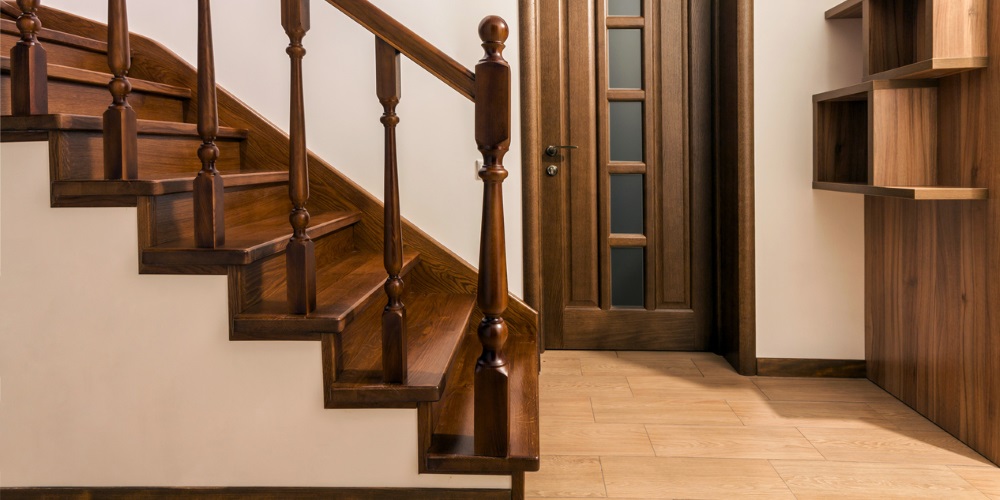
Dark wood
|
Victoria: Dark wooden staircases can be wonderful if styled correctly. Good-quality lighting in keeping with the surrounding is certainly a priority. Make sure you keep any wall colours, artwork and accessories a light colour. This will create a lovely contrast, lighten the area and show your dark wooden staircase in all its glory. |
Katy: A dark-wood staircase generally feels a little more traditional. You can complement them using rich paint colours on the wall, perhaps Little Greene Hicks Blue or Goblin. Or even a wonderful hand-printed William Morris wallpaper. |
|
|
Louisa: For a dark wood balustrade, I’d always suggest a dark-grey oak or warm walnut stain to keep the look timeless yet current—this works for all styles. |
Charlotte: Dark wood is a classic look, reminiscent of old stately homes, which would have been lit with candles. You can recreate this look using wall lights with low-wattage lamps. This effect may make the room dark, so unless I was trying to recreate the atmosphere of an old house, I’d be looking to paint the walls in a light shade of a complementary colour and bring as much light into the room as possible with downlights. |
|
|
Evette: Dark wooden stairs found in more traditional-style homes lend themselves to strong patterned carpets or runners, which make a statement and anchor the strong colour of the wood. In Georgian homes—due to the extended-height ceilings—it’s advantageous to use dark wooden banisters as they draw the eye to elegant curves and delicate spindles. |
||
Katy: A dark-wood staircase generally feels a little more traditional. You can complement them using rich paint colours on the wall, perhaps Little Greene Hicks Blue or Goblin. Or even a wonderful hand-printed William Morris wallpaper.
Charlotte: Dark wood is a classic look, reminiscent of old stately homes, which would have been lit with candles. You can recreate this look using wall lights with low-wattage lamps. This effect may make the room dark, so unless I was trying to recreate the atmosphere of an old house, I’d be looking to paint the walls in a light shade of a complementary colour and bring as much light into the room as possible with downlights.
Louisa: For a dark wood balustrade, I’d always suggest a dark-grey oak or warm walnut stain to keep the look timeless yet current—this works for all styles.
Victoria: Dark wooden staircases can be wonderful if styled correctly. Good-quality lighting in keeping with the surrounding is certainly a priority. Make sure you keep any wall colours, artwork and accessories a light colour. This will create a lovely contrast, lighten the area and show your dark wooden staircase in all its glory.
Evette: Dark wooden stairs found in more traditional-style homes lend themselves to strong patterned carpets or runners, which make a statement and anchor the strong colour of the wood. In Georgian homes—due to the extended-height ceilings—it’s advantageous to use dark wooden banisters as they draw the eye to elegant curves and delicate spindles.
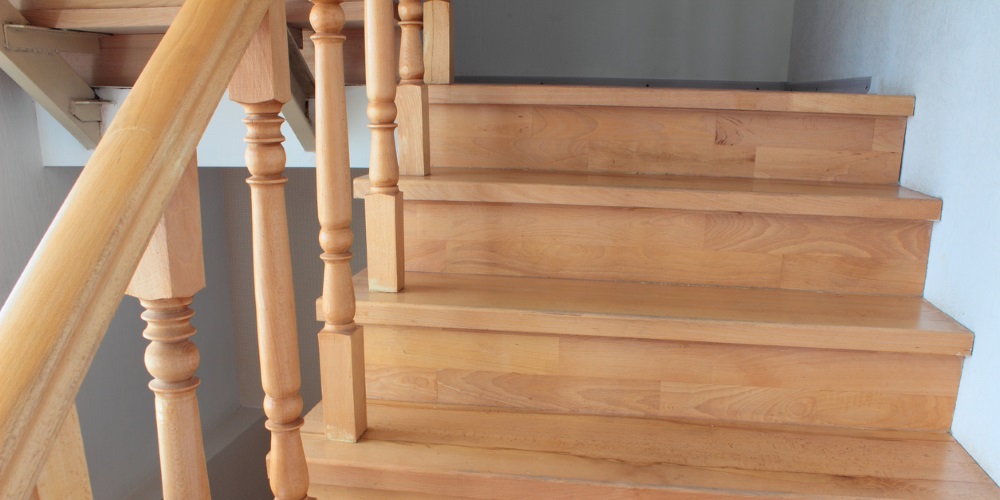
Light wood
|
Victoria: In my opinion, light wood is one of the most versatile designs of staircase. It’s great for not engulfing smaller spaces. In larger spaces the light wood allows you to place more emphasis on the style and accessories of the staircase’s surroundings, whether that’s the flooring, wall colour or statement artwork. |
||
|
Katy: A light-wood staircase gives a touch more of a contemporary, perhaps even Scandinavian feel. I’d style this with light walls and woodwork and soften with a loop runner up the centre of the stairs. |
Louisa: Light wood is coming back. I’d recommend using a washed wax finish though to give it a modern twist and to tone down the natural ‘orange’ within the wood. Works well for a ‘Scandi’ look. |
|
|
Evette: Decorating with galleried walls works well, whether it be a collection of mirrors, quirky artwork, family photography or a series of interlinked themes. There’s nothing to say we shouldn’t be enjoying the journey of venturing upstairs to our homes, so why not make it an occasion? |
Charlotte: Light wood is quite a contemporary style throughout the home. Much of the styling advice I’d give is quite similar to dark wood, but with light shades of wood you can afford to go a couple of shades darker with the walls. Again, I’d consider putting downlights into the room to give a contemporary look. |
|
Victoria: In my opinion, light wood is one of the most versatile designs of staircase. It’s great for not engulfing smaller spaces. In larger spaces the light wood allows you to place more emphasis on the style and accessories of the staircase’s surroundings, whether that’s the flooring, wall colour or statement artwork.
Charlotte: Light wood is quite a contemporary style throughout the home. Much of the styling advice I’d give is quite similar to dark wood, but with light shades of wood you can afford to go a couple of shades darker with the walls. Again, I’d consider putting downlights into the room to give a contemporary look.
Louisa: Light wood is coming back. I’d recommend using a washed wax finish though to give it a modern twist and to tone down the natural ‘orange’ within the wood. Works well for a ‘Scandi’ look.
Evette: Decorating with galleried walls works well, whether it be a collection of mirrors, quirky artwork, family photography or a series of interlinked themes. There’s nothing to say we shouldn’t be enjoying the journey of venturing upstairs to our homes, so why not make it an occasion?
Katy: A light-wood staircase gives a touch more of a contemporary, perhaps even Scandinavian feel. I’d style this with light walls and woodwork and soften with a loop runner up the centre of the
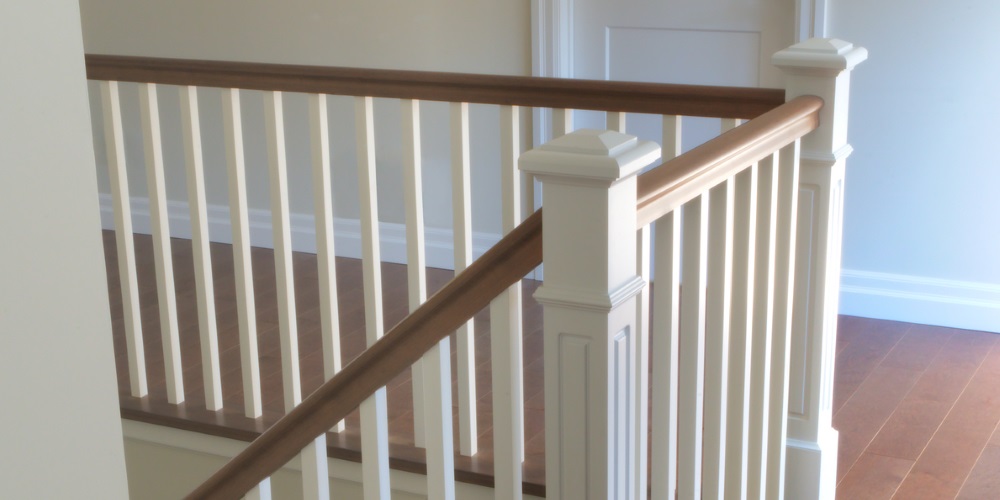
White-painted wood
|
Charlotte: Painting wood can hide a multitude of sins, particularly if your balustrade isn’t in good enough condition to stain and polish. However, it does mean that you need to find a feature of the room to accentuate. You could do this by painting the walls, but as a lighting designer I’d suggest creating a feature light by hanging a cluster of pendants of different lengths at the top of the stairs. I’d fit an eclectic mix of Edison lamps into these to make a feature. |
Louisa: Timeless, fresh and make sure it is white—brilliant white—as ivory or cream just looks dirty. White is great used on traditional spindles, with a dark wooden handrail, styled with a grey carpet. |
|
|
Victoria: White-painted staircases run the risk of looking boring. However, combine it with a contrasting coloured wall and it will look great! Depending on how brave you feel, this would look effective with a bright coral wall or a moody blue or green hue. This will transform a boring staircase into a statement piece! |
Katy: I would say a white-painted staircase is a touch more of a classic style. This is a homeowner who wants something nice and neutral that they can live with but who perhaps doesn’t want to make too much of a statement. To soften the area a fine striped carpet could work really well up the stairs or some beautifully framed artwork running up the staircase wall. |
|
Katy: I would say a white-painted staircase is a touch more of a classic style. This is a homeowner who wants something nice and neutral that they can live with but who perhaps doesn’t want to make too much of a statement. To soften the area a fine striped carpet could work really well up the stairs or some beautifully framed artwork running up the staircase wall.
Charlotte: Painting wood can hide a multitude of sins, particularly if your balustrade isn’t in good enough condition to stain and polish. However, it does mean that you need to find a feature of the room to accentuate. You could do this by painting the walls, but as a lighting designer I’d suggest creating a feature light by hanging a cluster of pendants of different lengths at the top of the stairs. I’d fit an eclectic mix of Edison lamps into these to make a feature.
Louisa: Timeless, fresh and make sure it is white—brilliant white—as ivory or cream just looks dirty. White is great used on traditional spindles, with a dark wooden handrail, styled with a grey carpet.
Victoria: White-painted staircases run the risk of looking boring. However, combine it with a contrasting coloured wall and it will look great! Depending on how brave you feel, this would look effective with a bright coral wall or a moody blue or green hue. This will transform a boring staircase into a statement piece!
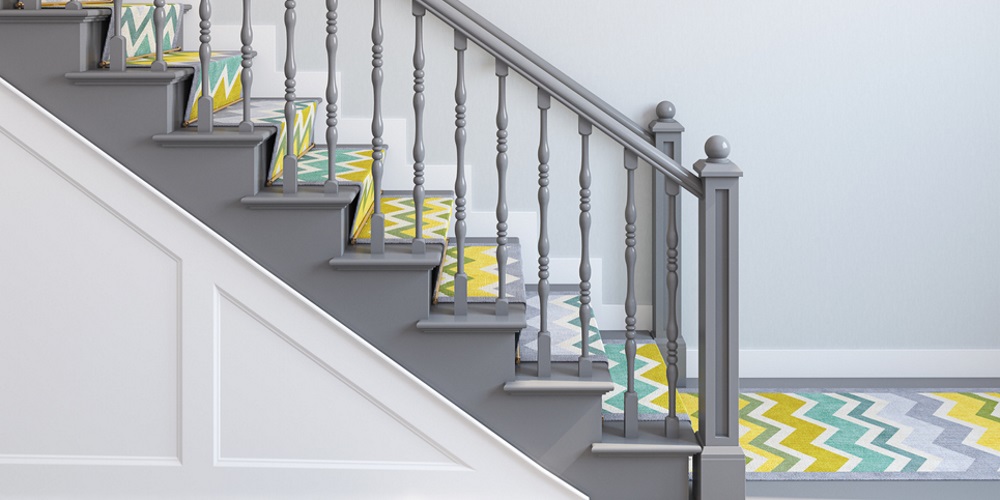
Coloured-painted wood
|
Charlotte: Coloured-painted wood can be tricky, but a really interesting idea is to choose a few complementary shades of the same colour and paint different parts of the banister in different shades. For example, if I were decorating a seaside holiday cottage, I’d be looking to go for a range of teals—perhaps Dulux Lagoon Falls for the uprights with the rest of the staircase in Ocean Ripple. Carrying on the nautical theme, I may look to use Marine Splash in the rest of the room. I’d look to fit bright downlights to lift the light levels in the room. |
Louisa: For a coloured-painted look, I’d always go dark and keep all other elements light. Let the dark‑painted balustrade become the main feature here. |
|
Victoria: Keep the walls white or off-white and introduce an attention-grabbing colour for the staircase. It instantly turns what could be solely a functional element of your house into a key design piece. |
|
|
Katy: A painted staircase lets a hallway make more of a statement. I’d complement this with a beautiful wooden parquet floor, particularly if the staircase was painted a dark, moody colour. A traditional column radiator would complete the look and perhaps some stained glass in the front door. |
Charlotte: Coloured-painted wood can be tricky, but a really interesting idea is to choose a few complementary shades of the same colour and paint different parts of the banister in different shades. For example, if I were decorating a seaside holiday cottage, I’d be looking to go for a range of teals—perhaps Dulux Lagoon Falls for the uprights with the rest of the staircase in Ocean Ripple. Carrying on the nautical theme, I may look to use Marine Splash in the rest of the room. I’d look to fit bright downlights to lift the light levels in the room.
Katy: A painted staircase lets a hallway make more of a statement. I’d complement this with a beautiful wooden parquet floor, particularly if the staircase was painted a dark, moody colour. A traditional column radiator would complete the look and perhaps some stained glass in the front door.
Victoria: Keep the walls white or off-white and introduce an attention-grabbing colour for the staircase. It instantly turns what could be solely a functional element of your house into a key design piece.
Louisa: For a coloured-painted look, I’d always go dark and keep all other elements light. Let the dark‑painted balustrade become the main feature here.
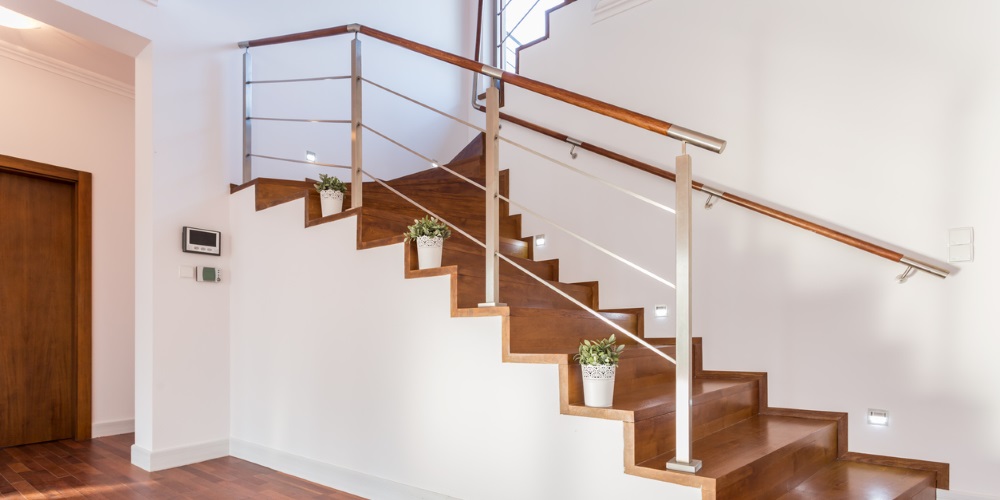
Combination of materials
|
Victoria: This can be a cost‑effective way of introducing a more modern look to this area of your house. I always think the best way to style these types of staircase is with statement lighting. If the staircase has any fancy metalwork or detail, don’t detract from this with overpowering surroundings. Let the combination of materials and quality lighting do all the work for you! |
Charlotte: Combinations are tricky, but the feature here comes from the contrast between the different materials. If you had a metal and wood staircase, I’d look to make the different materials different colours to bring out the difference—perhaps black metal uprights with a light-wood handrail. In this case, I’d again go for downlights for a sleek, contemporary look. |
Katy: If you’re using many different materials with the staircase and surrounding area, I’d keep the rest of the decor minimal, as the materials themselves create a gorgeous focal point. The one thing I would pay more attention to is lighting, whether this is lighting that leads you up the stairs, wall lighting or a cluster statement light. This is going to be key to highlighting all those lovely different qualities in the materials. |
|
Louisa: A combination of wood and glazed panels—rather than balustrades—works well for a contemporary scheme. |
||
Victoria: This can be a cost‑effective way of introducing a more modern look to this area of your house. I always think the best way to style these types of staircase is with statement lighting. If the staircase has any fancy metalwork or detail, don’t detract from this with overpowering surroundings. Let the combination of materials and quality lighting do all the work for you!
Charlotte: Combinations are tricky, but the feature here comes from the contrast between the different materials. If you had a metal and wood staircase, I’d look to make the different materials different colours to bring out the difference—perhaps black metal uprights with a light-wood handrail. In this case, I’d again go for downlights for a sleek, contemporary look.
Louisa: A combination of wood and glazed panels—rather than balustrades—works well for a contemporary scheme.
Katy: If you’re using many different materials with the staircase and surrounding area, I’d keep the rest of the decor minimal, as the materials themselves create a gorgeous focal point. The one thing I would pay more attention to is lighting, whether this is lighting that leads you up the stairs, wall lighting or a cluster statement light. This is going to be key to highlighting all those lovely different qualities in the materials.





